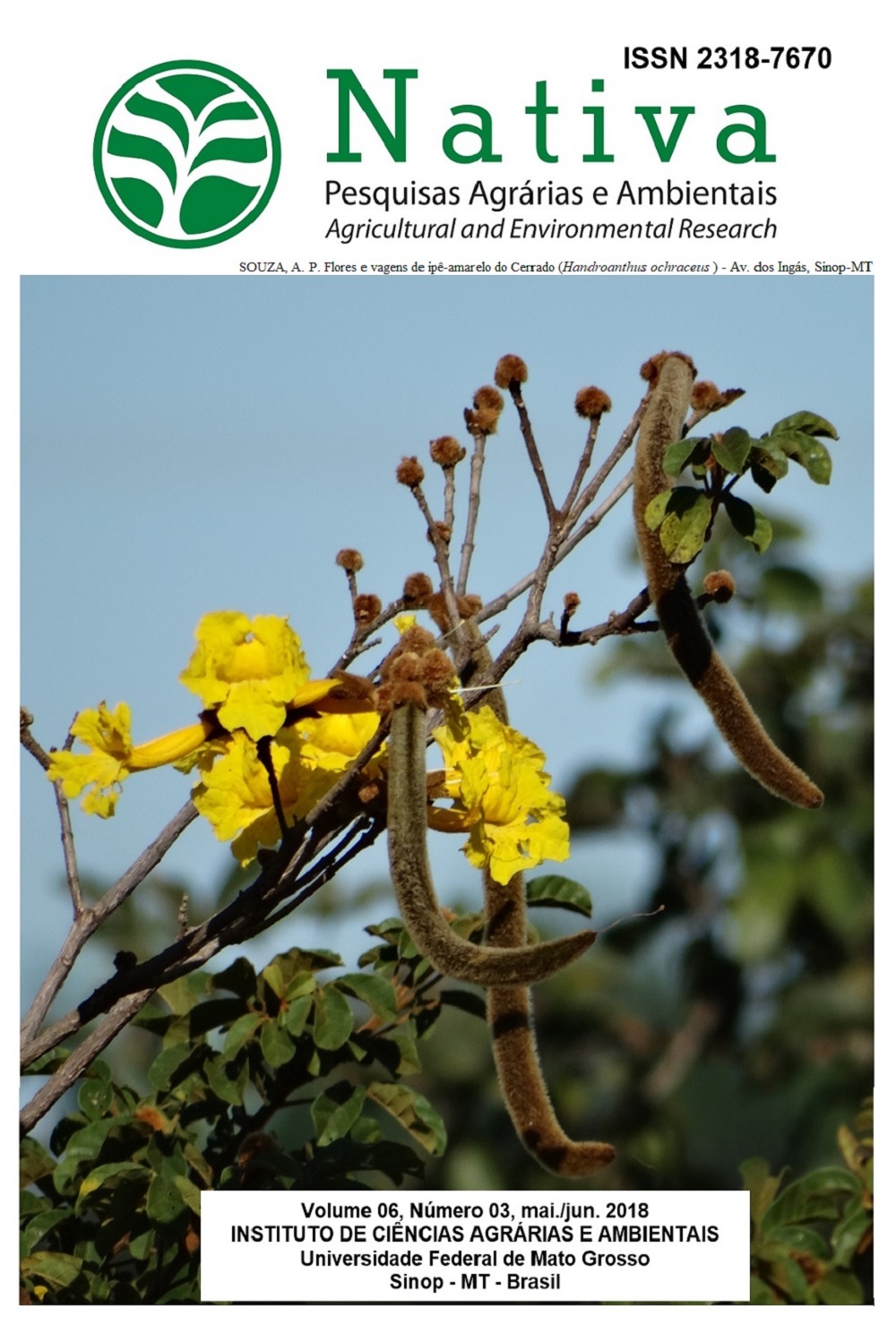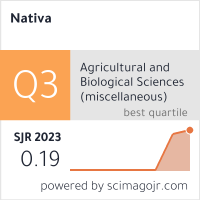CONTROLE BIOLÓGICO DE Bursaphelenchus cocophilus POR RIZOBACTÉRIAS E Trichoderma spp.
DOI:
https://doi.org/10.31413/nativa.v6i3.4531Resumo
O objetivo do trabalho foi avaliar o potencial de rizobactérias e Trichoderma spp. no controle biológico de Bursaphelenchus cocophilus. Foram avaliados 19 isolados de Pseudomonas spp. (P), 29 de Bacillus spp. (B) e 27 de Trichoderma spp. (T), obtidos de plantio comercial. Os isolados foram caracterizados quanto a produção de compostos bioquímicos. Foi avaliada a taxa de mortalidade de B. cocophilus in vitro e in vivo, neste último realizou-se também a quantificação das enzimas relacionadas à patogênese. Os isolados B14 e P41 proporcionaram 69% e 56% de taxa de mortalidade de nematoides, respectivamente e foram tanto proteolíticos como solubilizadores de fosfato. Os isolados T41 e T54 apresentaram 96% de mortalidade de B. cocophilus in vitro e foram produtores de quitinases, protease e sideróforos. No experimento in vivo, os isolados de rizobactérias B14, B23 e P23 promoveram maior taxa de mortalidade do B. cocophilus do que os demais tratamentos. As mudas de coqueiro inoculadas com o B. cocophilus apresentaram aumento nas atividades das enzimas peroxidases, quitinase e β-1,3-glucanases, quando comparadas com a testemunha (mudas não inoculadas). Os isolados B41, P14, T41 e T54 apresentaram-se como potenciais agentes de controle biológico do B. cocophilus.
Palavras-chave: anel vermelho, antagonismo, nematoid.
BIOLOGIC CONTROL OF Bursaphelenchus cocophilus WITH RHIZOBACTERIA AND Trichoderma isolates
ABSTRACT:
The purpose of this study was to evaluate the potential of rhizobacteria Pseudomonas spp. and Bacillus spp. and Trichoderma spp. isolates on the biological control of the nematode Bursaphelenchus cocophilus. The potential biological control isolates (48 rhizobacteria and 27 Trichoderma spp.) were characterized biochemically. The biological control experiments were carried out "in vitro" and "in vivo", and in the later one, the mortality rate of the nematodes and the pathogenesis related enzymes were evaluated. Rhizobacterial isolates B14 and P41 provided a high nematode mortality rate (69% and 56%, respectively) and both were proteolytic and phosphate solubilizers. In the "in vivo" experiment, rhizobacterial isolates B14, B23 and P23 tested the highest mortality rates of B. cocophilus than the isolates of Trichoderma spp. and of the control as coconut saplings challenged with B. cocophilus showed indices higher in enzyme activities, peroxidases, chitinase and β-1,3-glucanases when compared to witness (seedling not inoculated). The isolates B41, P14, T41 and T54 were presented as potential biological control agents of B. cocophilus.
Keywords: red ring, antagonism, nematode.
Referências
ABDALLAH, R. A. B.; MOKNI-TLILI, S.; NEFZI, A.; JABNOUN-KHIAREDDINE, H.; DAAMI-REMADI. Biocontrol of Fusarium wilt and growth promotion of tomato plants using endophytic bacteria isolated from Nicotiana glauca organs. Biocontrol, v. 16, p. 80-88, 2016. DOI: http://doi:10.1016/j.biocontrol.2016.03.005.
AFFOKPON, A.; COYNE, D. L.; HTAY, C. C.; AGBÈDÈ, R. D.; LAWOUIN, L.; COOSEMANS, J. Biocontrol potential of native Trichoderma isolates against root-knot nematodes in West African vegetable production systems. Soil Biology, v. 43, p. 600-608, 2011. DOI: http://dx.doi.org/10.1016/j.soilbio.2010.11.029.
AGRAWAL, T.; KOTASTHANE, A. S. Chitinolytic assay of indigenous Trichoderma isolates collected from different geographical locations of Chhattisgarh in Central India. SpringerPlus, v. 1, n. 73, p. 2-10, 2012. DOI: http://dx.doi.org/10.1186/2193-1801-1-73.
AGRIOS, G. N. Plant pathology. 5. ed. Amsterdam: Elsevier, 2005. 922 p.
AGROFIT. Busca por produtos formulados. Disponível em: <http://agrofit.agricultura.gov.br/ agrofit_cons/principal_agrofit_cons>. Acesso em: 17 jan 2017.
BENITE, A. M. C.; MACHADO, S. P.; MACHADO, B. C. Sideróforos: uma resposta dos microorganismos. Química Nova, Rio de Janeiro, v. 25, n. 6, p. 1155-1164, 2002. DOI: http://dx.doi.org/10.1590/S0100-40422002000700016.
BERG, G.; ROSKOT, N.; STEIDLE, A.; EBERL, L.; ZOCK, A.; SMALLA, K. Plant-Dependent Genotypic and Phenotypic Diversity of Antagonistic Rhizobacteria Isolated from Different Verticillium Host Plants. Applied and environmental microbiology, v. 68, n. 2, p. 3328–3338, 2002a.
BERG, G.; KRECHEL, A.; DITZ, M.; SIKORA, R. A.; ULRICH, A.; HALLMANN, J. Endophytic and ectophytic potato-associated bacterial communities differ in structure and antagonistic function against plant pathogenic fungi. FEMS Microbiololy Ecology, v. 51, n. 2, p. 215–229, 2002b. DOI: http://doi: 10.1016/j.femsec.2004.08.006.
CHAVES, N. P.; POCASANGRE, L. E.; ELANGO, F.; ROSALES, E.; SIKORA. R. Combining endophytic fungi and bacteria for the biocontrol of Radopholus similis (Cobb) Thorne and for effects on plant growth. Scientia Horticulturae, v. 122, n .3, p. 472-478, 2009. DOI: http://dx.doi.org/10.1016/j.scienta.2009.05.025.
CHEN, C.; BÉLANGER R. R.; BENHAMOU, N.; PAULITZ, T. C. Defense enzymes induced in cucumber roots by treatment with plant growthpromoting rhizobacteria (PGPR) and Pythium aphanidermatum. Physiological and Molecular Plant Pathology, v. 56, p. 13-23, 2000. DOI: https://doi.org/10.1006/pmpp.1999.0243.
CHEN, L.; JIANG, H.; CHENG, O.; CHEN, J.; WU, G.; KUMAR, A.; SUN, M.; LIU, Z. Enhanced nematicidal potential of the chitinase pachi from Pseudomonas aeruginosa in association with Cry21Aa. Scientific Reports, v. 5, p. 1-11, 2015. DOI: http://doi:10.1038/srep14395.
FAOSTAT. Food and Agriculture Organization of the United Nations, 2014. Disponível em: <http://faostat.fao.org/site/567>. Acesso em: 17 Jan 2017.
GERBER, K.; GIBLIN-DAVIS, R. M. Association of the Red Ring Nematode and Other Nematode Species with the Palm Weevil, Rhynchophorus palmarum. Journal of Nematology, v. 22, n. 2, p. 143-149, 1990.
HAMMERSCHMIDT, R.; NUCKLES, E. M.; KUC, J. Association of enhanced peroxidase activity with induced systemic resistance of cucumber to Colletotrichum lagenarium. Physiology Plant Pathology, v. 20, p. 73-82, 1982. DOI: https://doi.org/10.1016/0048-4059(82)90025-X.
HIGAKI, W. A.; ARAÚJO, F. F. Bacillus subtilis e abamectina no controle de nematoides e alterações fisiológicas em algodoeiro cultivado em solos naturalmente infestado. Nematropica, v. 42, n. 2, 2012.
KATSANTONIS, D.; HILLOCKS, R. J.; GOWEN S. Enhancement of germination of spores of Verticillium dahliae and Fusarium oxysporum f.sp. vasinfectum in vascular fluid from cotton plants infected with the root-knot nematode. Phytoparasitica, v. 33, p. 215-224, 2005. DOI: https://DOI: 10.1007/BF02979858.
KIEWNICK, S.; SIKORA, R. A. Biological control of the root-knot nematode Meloidogyne incognita byPaecilomyces lilacinus strain 251. Biological Control, v. 38, p.179–187, 2006. DOI: http://dx.doi.org/10.1016/j.biocontrol.2005.12.006.
KLEMENT, Z.; RUDOLPH, K.; SANDS, D. C. Methods in Phytobacteriology. Akadémiai Kiadó: Budapest. 1990. 568 p.
LEVER, M. A new reaction for colorimetric determination of carbohydrates. Analytical Biochemistry, v. 47, p. 273-279, 1972. DOI: http://dx.doi.org/10.1016/0003-2697(72)90301-6.
LUNGE, A. G.; PATIL, A. S. Characterization of efficient chitinolytic enzyme Producing Trichoderma species: a tool for better antagonistic approach. International Journal of Science, v. 1, n. 5, p. 377-385, 2012.
MACHADO, V.; BERLITZ, D. L.; MATSUMURA, A. T. S.; SANTIN, R. C. M.; GUIMARÃES, A.; SILVA, M. E.; FIUZA, L. M. Rizobactérias como agentes de controle biológico de fitonematoides. Oecologia Australia, v. 16, n. 2, p. 65-182, 2012.
MILLER, G. L. Use of dinitrosalicylic acid reagent for determination of reducing sugar. Analytical Chemistry, v. 31, n. 3, p. 426-428, 1959. DOI: http:DOI: 10.1021/ac60147a030.
NAWANI, N. N.; KAPADNIS, B. P. Optimization of chitinase production using statistics based experimental designs. Process Biochemistry, v. 40, p. 651-660, 2005. DOI: https://doi.org/10.1016/j.procbio.2004.01.048.
RYU, E. A simple method for differentiation between Gram-positive and Gramnegative organisms without staining. Kitazato Archives of Experimental Medicine, v. 17, p. 58-63, 1940.
SAHEBANI, N.; HADAVI, N. Biological control of the root-knot nematode Meloidogyne javanica by Trichoderma harzianum, Soil Biology and Biochemistry, v. 40, n. 8, p. 2016-2020, 2008. DOI: https://doi.org/10.1016/j.soilbio.2008.03.011.
SANHUEZA, R. M. V.; MELO, I. S. Métodos usados no biocontrole de fitopatógenos. 21 ed. Bento Gonçalves: Embrapa Uva e Vinho, 2007. 141p.
SCHWYN, B. Y; NEILANDS J. B. Universal chemical assay for the detection and determination of siderophores”. Analytical biochemistry, v. 160, p. 47-56, 1987. DOI: https://doi.org/10.1016/0003-2697(87)90612-9.
SHARON, E.; BAR-EYAL, M.; CHET,I.; HERRERA-ESTRELLA, A.; KLEIFELD, O.; SPIEGEL, Y. Biological Control of the Root-Knot Nematode Meloidogyne javanica by Trichoderma harzianum. Phytopathology, v. 91, n. 7, p. 687-693, 2001. DOI: https://doi: 10.1094/PHYTO.2001.91.7.687.
TU, Q.; CHEN, J.; GUO, J. Screening and identification of antagonistic bacteria with potential for biological control of Penicillium italicum of citrus fruits. Scientia Horticulturae, v. 150, p. 125–129, 2013. DOI: http://dx.doi.org/10.1016/j.scienta.2012.10.018.
TZEAN, Y.; CHOU, T. H.; HSIAO, C. C.; SHU, P. Y.; WALTON, J. D.; TZEAN, S. S. Cloning and characterization of cuticle-degrading serine protease from nematode-trapping fungus Arthrobotrys musiformis. Mycoscience, v. 57, p. 136-143, 2016. DOI: http://dx.doi.org/10.1016/j.myc.2015.12.003.
VASCONCELLOS, R. L. F.; SILVA, M. C. P.; RIBEIRO, C. M.; CARDOSO, E. J.B. N. Isolation and screening for plant growth-promoting (PGP) actinobacteria from Araucaria angustifolia rhizosphere soil. Scientia Agricola, v. 67, n. 6, p. 743-746, 2010. DOI: http://dx.doi.org/10.1590/S0103-90162010000600019.
VITTONE, G. Genetic and Functional Analysis of Siderophores in Trichoderma virens. Tese (Doutorado) Texas, Department of Plant Pathology A; M University, 2008. 97 f.
WEI, L.; SHAO, Y.; WAN, J.; FENH, H.; HUANG, H.; ZHOU, Y. Isolation and Characterization of a Rhizobacterial Antagonist of Root-Knot Nematodes. PLoS ONE, v. 9, n. 1, p. 1-7, 2014. DOI: http://dx.doi.org/10.1016/j.biocontrol.2015.08.004.
YOUSSEF, S. A; TARTOURA, K. A.; ABDELRAOUF, G.A. Evaluation of Trichoderma harzianum and Serratia proteamaculans effect on disease suppression, stimulation of ROS-scavenging enzymes and improving tomato growth infected by Rhizoctonia solani. Biological Control, v. 100, n .79–86, 2016. DOI: http://dx.doi.org/10.1016/j.biocontrol.2016.06.001.
ZERAIK, A. E.; SOUZA, F. S.; FATIBELLO-FILHO, O. Desenvolvimento de um spot test para o monitoramento da atividade da peroxidase em um procedimento de purificação. Quimica Nova, v. 31, n. 4, p. 731-734, 2008. DOI: http://dx.doi.org/10.1590/S0100-40422008000400003.
ZHANG, J.; LI, Z.; YUAN, H.; SUN, B.; LI, H. Biological control of the cereal cyst nematode (Heterodera filipjevi) by Achromobacter xylosoxidans isolate 09X01 and Bacillus cereus isolate 09B18. Biological Control, v. 92, p. 1-6, 2016. DOI: http://dx.doi.org/10.1016/j.biocontrol.2015.08.004.
ZHANG, S.; GAN, Y.; XU, B.; XUE, Y. The parasitic and lethal effects of Trichoderma longibrachiatum against Heterodera avenae. Biological Control, v. 72, p. 1–8. 2014. DOI: http://dx.doi.org/10.1016/j.biocontrol.2014.01.009.
Downloads
Publicado
Edição
Seção
Como Citar
Licença
Direitos Autorais para artigos publicados nesta revista são do autor, com direitos de primeira publicação para a revista. Em virtude de a aparecerem nesta revista de acesso público, os artigos são de uso gratuito, com atribuições próprias, em aplicações educacionais e não-comerciais.
A artigos publicados nessa revista, podem ser reproduzidos parcialmente ou utilizados como referência por outros autores, desde que seja cita a fonte, ou seja, a Revista Nativa.
Copyright for articles published in this journal are the authors, with first publication rights granted to the journal. The journal shows open access, and articles are free to use, with proper attribution, in educational and non-commercial.
The articles published in this journal may be reproduced in part or used as a reference by other authors, provided that the source is quoted.






